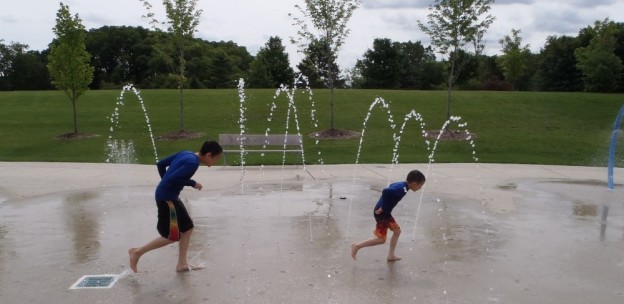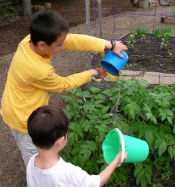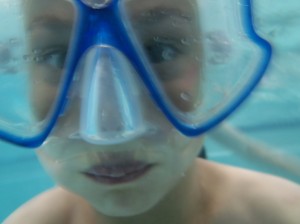
Parenting  Doing wet chores as a family is a way to teach the practical purpose of water without the threat of immersion. When we give our pet guinea pig an outdoor bath during the summer, we often have a crowd of neighborhood children helping us - the pet’s bath becomes a social event, not a chore. Other chores include:
Doing wet chores as a family is a way to teach the practical purpose of water without the threat of immersion. When we give our pet guinea pig an outdoor bath during the summer, we often have a crowd of neighborhood children helping us - the pet’s bath becomes a social event, not a chore. Other chores include:
 of water in or near his nose made him panic. He could not learn how to swim because of his fear. After several years of unsuccessful swimming lessons, an instructor suggested that we get a pair of goggles that covered his nose and eyes. When my son realized that his nose was protected from water, he began to swim laps instead of flailing in the water.
of water in or near his nose made him panic. He could not learn how to swim because of his fear. After several years of unsuccessful swimming lessons, an instructor suggested that we get a pair of goggles that covered his nose and eyes. When my son realized that his nose was protected from water, he began to swim laps instead of flailing in the water.
6. Water safety
Phobias are usually based on the possibility of danger, even if it is a remote possibility. When I acknowledged the real dangers of water and helped my son find ways to be safe, his comfort near water increased and his fear decreased. Many individuals with disabilities are both attracted to water and fearful of it, a particularly dangerous combination with an increased risk for drowning. Safety strategies include:
6 Ways You Can Help Your Child With Special Needs Overcome a Fear of Water
For many families, a fear of water can be a major obstacle to summer fun. Fortunately, warm weather offers many opportunities to overcome this fear without distress. A severe fear of water is known as hydrophobia. The fear may be based on a fear of drowning, a fear of becoming messy, a fear of losing control or a fear of being unable to escape. Some individuals are highly sensitive to the texture and sounds of water, and may develop an aversion based on that discomfort. In all of these cases, it is easy to make the fear or aversion worse by failing to find the root cause or by forcing immersion in water before the person is ready. It is not so easy to alleviate a fear of water - but it is definitely possible. These are some of the activities that I used at home to mitigate my children’s sensitivity to water and fear of immersion.1. Water play
A small container of water is less threatening than a large container when exploring the texture, sounds and other natural properties of water. The only rule for water play is to make it as fun as possible, which means no splashing on the face or dunking. Consider using the following tools:- measuring cups
- ladles or spoons
- sponges
- ice cubes
- a drop of food coloring
- a bucket
- a sink full of soapy water
2. Water chores
 Doing wet chores as a family is a way to teach the practical purpose of water without the threat of immersion. When we give our pet guinea pig an outdoor bath during the summer, we often have a crowd of neighborhood children helping us - the pet’s bath becomes a social event, not a chore. Other chores include:
Doing wet chores as a family is a way to teach the practical purpose of water without the threat of immersion. When we give our pet guinea pig an outdoor bath during the summer, we often have a crowd of neighborhood children helping us - the pet’s bath becomes a social event, not a chore. Other chores include:
- watering plants
- washing the car
- wiping the bathroom counter
- mopping the floor
- doing laundry
- washing dishes
- rinsing paint brushes after craft time
3. Allow some control
Loss of control is part of every fear. When a person is able to control one aspect of a water experience, it may mitigate the fear enough so that the person can enjoy the experience. For example, my older son was fearful of putting his face in water, because the feeling of water in or near his nose made him panic. He could not learn how to swim because of his fear. After several years of unsuccessful swimming lessons, an instructor suggested that we get a pair of goggles that covered his nose and eyes. When my son realized that his nose was protected from water, he began to swim laps instead of flailing in the water.
of water in or near his nose made him panic. He could not learn how to swim because of his fear. After several years of unsuccessful swimming lessons, an instructor suggested that we get a pair of goggles that covered his nose and eyes. When my son realized that his nose was protected from water, he began to swim laps instead of flailing in the water.
4. Daily rituals
Water is less threatening when it is a non-negotiable everyday activity. I discovered that requiring a daily 2 minute bath resulted in more cooperation than bathing every other day. If a bath is too uncomfortable, try washing with a wet washcloth, or consider allowing some daily play time with a handheld shower head.5. Water temperature
I have one child who prefers a hot bath and one who insists on a lukewarm bath. Safe experimentation with different temperatures is an effective way to reduce anxiety about water. Offer containers of water at various temperatures and demonstrate how the bath’s temperature can be changed.6. Water safety
Phobias are usually based on the possibility of danger, even if it is a remote possibility. When I acknowledged the real dangers of water and helped my son find ways to be safe, his comfort near water increased and his fear decreased. Many individuals with disabilities are both attracted to water and fearful of it, a particularly dangerous combination with an increased risk for drowning. Safety strategies include:
- providing a life jacket
- using different types of floats and tubes
- learning how to tread water
- practicing the buddy system
- signing up for individualized swimming lessons



